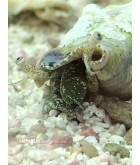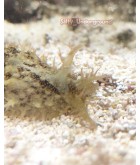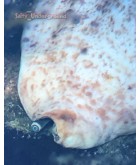Below is a brief description of the fire corals. They are in the Class Hydrozoa, Order Milleporina, and Family Milleporidae. There is only one extant genus, Millepora, containing the corals with common names like fire corals, box corals, and stinging corals.
Although they are called fire corals, Millepora sp. aren't really like the other corals at all. They are Cnidarians, cousins of anemones and jellyfish, also stingers. The pain can last from a couple of days to a couple of weeks if you accidentally touch a fire coral. If that wasn't bad enough, fire corals typically have a sharp skeleton which can scrape unwary divers. Some home remedies for the sting of a fire coral are using meat tenderizer (I like it mixed with petroleum jelly to make a paste) or ammonia (Urine is almost always available!).
Structurally speaking, Millepora corals are reef building and have calcareous skeletons. Their polyps don't even extend past their skeletons. Instead, they are in pores in the skeleton surface. There are three types of pores: dactylopores, gastropores, and ampullae. Dactylopores have special polyps with nematocystic retractable extensions, dactylozooids, used for capturing prey. They give the fire corals a fuzzy appearance due to their hair like structure. Gastropores, on the other hand, have the gastrozooids, the feeding polyps. Once the dactlyozooids have captured the prey, the gastrozooids swell out and the dactylozooids bring the food in to them. The third type of pore, the ampullae, is used for reproduction in producing medusae. A medusa is a juvenile fire coral. It swims free in the current, is shaped as an umbrella, and is common among other Cnidarians in the Class Hydrozoa. In fact, they may develop in less than a month, unlike the years it takes the stony corals to sexually reproduce.
Water flow greatly affects the many growth forms adopted by fire corals. They can be branching, laminar, massive, and encrusting. When fire coral colonies are encrusting, they can often envelope nearby corals. Encrusting is another form of reproduction for Millepora sp., as they can generate daughter colonies in this manner. Sometimes, they are also described as being shaped like lettuce, lace, and boxes.
Millepora corals are notoriously hardy. They are the first corals to appear on new reefs and the last holdouts on dying reefs. They are more populous in waters with high light intensity and high water current in shallow waters to 130 feet deep. They typically make up a tenth to a half of a reef's coral population.
Due to their resilience, collecting fire corals does not seem to impact the coral reef communities significantly. However, it is encouraged, none the less, to breed them via aquaculture when possible. They are tolerable to a variety of light and water conditions, as well as being resistant to numerous diseases, parasites, and predators. Because of these factors, Millepora corals make great candidate for captive breeding programs.
Fire corals come in a variety of corals: yellow, green, brown, pink, and cream. These colors are a result of their reliance on photosynthesis (however, they will still eat plankton). In fact, they may be seen to “blow bubbles” as their zooxanthellae release oxygen as a byproduct of photosynthesis.
Common Species:M. alcicornis, M. complanata, M. dichotoma, M. exaesa, M. murrayi, M. nitida, M. platyphyllia, M. squarrosa, and M. tenella
References:
Borneman, E. (2001). Aquarium Corals: selection, husbandry, and natural history. Neptune City, NJ: T.F.H Publications.
Millepora. (2011). Retrieved on April 12, 2011 from http://en.wikipedia.org/wiki/Millepora.




